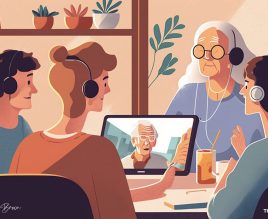Table of Contents
ToggleOur world is in the midst of a digital transformation, reshaping how we work, communicate, and live. The ‘future of work’ has arrived sooner than expected, spurred on by global disruptions like the COVID-19 pandemic. This change has given rise to remote work, underpinned by tools such as remote monitoring, video conferencing, and cloud-based software.
While some view this shift as a challenge, others see it as an opportunity – especially for older adults. Traditionally, retirement signaled an end to learning and evolving with technology. But in this digital age, older adults can break these age-old stereotypes, harnessing the power of remote work tools to continue making valuable contributions to the workforce.
The adaptation to these new work environments and tools might seem daunting. However, equipped with the right mindset and resources, older adults can efficiently navigate this digital landscape. After all, age is just a number when it comes to learning and adapting to the future of work.
Now, let’s dive into the world of remote monitoring, video conferencing, and cloud-based software, and how older adults can leverage these to stay relevant and productive.
Remote Work Tools for Older Adults
As the future of work unfolds, an array of digital tools have emerged to facilitate remote work. For older adults venturing into this new landscape, understanding and adapting to these tools can pave the way for a smoother transition.

Among the vast array of remote work tools, two aspects stand out for their significance: remote monitoring and time tracking. These technologies offer immense benefits in managing workloads, ensuring productivity, and fostering communication within virtual teams.
Remote Monitoring and Time Tracking
Remote monitoring and time-tracking tools are essential components of the remote work landscape. These technologies allow teams to track progress, manage tasks, and ensure accountability, all while maintaining a balance between work and personal life.
For older adults, embracing these tools can enhance their productivity and efficiency in the digital workspace. But first, let’s explore why time management is so critical in the realm of remote work.
1. Importance of Time Management in Remote Work
In a remote work setting, effective time management is key to productivity and work-life balance. As virtual work blurs the boundaries between professional and personal life, managing time can become challenging. However, it also presents an opportunity to develop routines and strategies that enhance productivity and personal wellbeing.
For older adults, these challenges might seem daunting, but mastering time management can provide structure and efficiency to their workday. It can help in prioritizing tasks, preventing burnout, and creating a sense of accomplishment. Remote monitoring and time tracking tools serve as digital aids, guiding older adults in managing their time effectively and maintaining a balanced lifestyle.
2. Real-life Examples and Case Studies
Take the case of Sarah, a 65-year-old consultant who decided to continue her career in a remote setup. She was initially hesitant about managing her time effectively in this new working environment.
However, with tools like Toggl for time tracking and Time Doctor for remote monitoring, she managed to create a routine and stick to it. These tools provided her with insightful reports on her work patterns, helping her identify peak productivity times and areas of improvement.
Similarly, in a case study by Harvard Business Review, a company implemented remote monitoring and time tracking tools for its remote employees, including those above the age of 60. The result was a significant increase in productivity and job satisfaction levels. The older adults, in particular, reported an improved sense of control and flexibility over their work.
These examples illustrate how remote monitoring and time tracking tools can foster productivity and satisfaction among older adults in a remote work setup. By leveraging these tools, they can effectively navigate the digital landscape, redefine their work-life balance, and make meaningful contributions to the future of work.
Video Conferencing Platforms
Another pillar of remote work is video conferencing. This technology has taken center stage in the virtual workspace, enabling face-to-face communication without geographical constraints. Platforms like Zoom, Microsoft Teams, and Google Meet have become household names, vital for meetings, presentations, or casual catch-ups.

For older adults, these platforms can bridge the gap between traditional and remote work settings, allowing them to maintain social interactions and collaborations, even from the comfort of their homes.
1. Features and Benefits for Older Adults
Video conferencing platforms are laden with features that cater to the needs of users of all ages. For older adults, these platforms offer several key benefits. Firstly, they provide visual and auditory engagement, crucial for effective communication. Secondly, they include features like screen sharing, which enables seamless collaboration and makes discussions more tangible and understandable.
Additionally, these platforms cater to the needs of individuals with accessibility issues. Features like automatic captioning can assist those with hearing difficulties, and adjustable text sizes can aid those with vision issues. These inclusive elements empower older adults to participate actively and contribute meaningfully in the remote workspace.
2. Real-life Examples and Case Studies
Consider the example of Robert, a 70-year-old project manager. Despite retiring from his regular job, he was keen on sharing his wealth of knowledge with younger generations. Using Zoom, he started conducting online workshops and mentorship programs. The features of the platform, such as breakout rooms for group discussions and screen sharing for presentations, made his sessions interactive and engaging.
In a broader context, a study published in the Journal of Gerontological Social Work revealed the positive impact of video conferencing on older adults during the pandemic. It showed how video calls helped seniors, many of whom were working remotely for the first time, to combat feelings of isolation and maintain their productivity levels.
These instances highlight how video conferencing platforms can offer older adults the means to stay connected, share their expertise, and continue their professional journey. By embracing these technologies, they can redefine their role in the digital workforce and contribute to the ever-evolving future of work.
Cloud-Based Software and Collaboration
In the realm of remote work, cloud-based software stands as a cornerstone. It enables seamless collaboration, document management, and data access from anywhere, at any time. For older adults, understanding and harnessing cloud technology can empower them to contribute efficiently to their teams, despite the distance. It can provide a sense of familiarity and continuity that bridges the gap between traditional and remote work settings.
Cloud Storage and Document Management
Cloud storage and document management are integral parts of remote work. Platforms like Google Drive, Dropbox, and Microsoft OneDrive allow teams to store, share, and edit documents in real time. This centralization of data enables efficient collaboration and ensures everyone is on the same page, regardless of their location.
1. Benefits for Older Adults
For older adults, the benefits of cloud storage and document management are manifold. These tools ensure accessibility, allowing them to access files anytime and from any device, providing flexibility that was unimaginable in the era of paper-based documentation. Moreover, they promote collaboration, as team members can simultaneously work on a document, see each other’s changes, and exchange ideas in real time.
Furthermore, these platforms often have intuitive interfaces, with features like search functions and folder organization that simplify navigation. This can help older adults adapt quicker and makes it easier for them to locate and manage their work. These benefits can significantly enhance the remote work experience for older adults, making them valuable members of the digital workforce.
2. Real-life Examples and Case Studies
For instance, take the story of Martha, a 68-year-old editor. After shifting to remote work, she was initially skeptical about how she would manage the document flow with her team spread across different time zones. However, using Google Drive’s cloud storage and real-time editing features, she was able to collaborate efficiently, review work, and provide feedback instantaneously.
Similarly, a case study by the University of Sydney examined the impact of cloud-based tools on older adults working in an NGO. The study found that these tools improved their productivity and job satisfaction. They reported that cloud-based document management enabled them to collaborate better, improved their ability to manage tasks, and enhanced their sense of connection with the team.
Virtual Collaboration and Communication Tools
Virtual collaboration and communication tools have become the backbone of remote work. Services like Slack, Asana, and Trello allow teams to communicate, manage tasks, and track progress in a virtual environment. These platforms are designed to simulate a physical office’s dynamics, fostering collaboration and productivity even when team members are miles apart.

1. Enhancing Teamwork and Productivity
These tools offer various features to facilitate teamwork and boost productivity. For older adults, features like threaded conversations can help keep track of discussions, while task management features can aid in organizing work and meeting deadlines.
Moreover, these platforms provide an avenue for social interaction, fostering a sense of community and camaraderie. This can help mitigate feelings of isolation that can often accompany remote work, especially for older adults accustomed to traditional office environments.
2. Real-life Examples and Case Studies
Consider Jim, a 67-year-old team leader who had to transition to a remote setup due to the pandemic. Using Slack, he managed to keep the team’s spirit alive with daily check-ins, virtual brainstorming sessions, and even casual banter.
On a larger scale, a report by PwC highlighted the impact of virtual collaboration tools on remote workers aged 60 and above. It found that these tools not only increased productivity but also improved their work-life balance and job satisfaction. They appreciated the flexibility these tools offered, which allowed them to manage their work, hobbies, and personal life more effectively. These examples underline the potential of virtual collaboration and communication tools to enhance teamwork, productivity, and job satisfaction among older adults in the digital age.
Digital Skills for Seniors
For older adults stepping into the remote work landscape, developing relevant digital skills is essential. These skills range from basic computer literacy to navigating popular remote work applications. Acquiring such competencies can open up new opportunities, enhance their ability to communicate and collaborate digitally, and ensure their active participation in the virtual workforce.
Essential Digital Skills for Remote Work
To thrive in a remote work setting, certain digital skills are non-negotiable. A basic understanding of computer operations, proficiency in remote work applications, and comfort with video conferencing and cloud platforms are vital. Let’s delve deeper into these core competencies.
1. Basic Computer Literacy
Basic computer literacy forms the foundation of all digital skills. It includes the ability to operate a computer or a laptop, manage files, install and update software, and use the internet effectively. For older adults, having these skills is crucial as they serve as a springboard for learning more complex digital tools and technologies.
It ensures their independence and confidence in navigating the digital world, be it sending an email, downloading an app, or protecting their devices from potential security threats. With these skills in their arsenal, older adults can break down barriers, paving the way for a fulfilling remote work journey.
2. Navigating Popular Remote Work Applications
In the remote work world, proficiency in using specific applications is key. This includes video conferencing tools like Zoom, cloud-based platforms like Google Drive, and collaboration tools like Slack. These applications facilitate communication, collaboration, and document management in a virtual environment.
For older adults, learning to navigate these applications effectively can make their remote work experience more efficient and enjoyable. It allows them to stay connected with their team, collaborate on tasks, and manage their work, all from the comfort of their homes.
Continuous Learning and Adaptation
In the fast-paced digital landscape, continuous learning and adaptation are paramount. Technologies evolve rapidly, and new tools emerge regularly. For older adults, embracing a mindset of lifelong learning can keep them abreast of these changes, allowing them to adapt and stay relevant in the remote work scene.
1. Online Courses and Resources for Older Adults
There is a multitude of online courses and resources tailored to older adults seeking to upskill digitally. Websites like Coursera and Udemy offer courses on basic computer skills, cloud computing, and remote work tools. Similarly, platforms like LinkedIn Learning provide resources on digital literacy and productivity software.
Many of these platforms offer self-paced learning, allowing older adults to learn at their convenience. By leveraging these resources, they can stay updated, learn at their own pace, and develop the skills necessary for effective remote work.
2. Real-life Examples and Case Studies
A compelling example is John, a 65-year-old who decided to continue working post-retirement. Despite having minimal digital skills, he undertook an online course on computer basics and remote work applications. With consistent effort, John managed to upskill, eventually landing a remote consulting role.
On a larger scale, a study by Age UK highlighted the role of online resources in improving digital literacy among older adults. The participants, many of whom were new to remote work, found these resources instrumental in gaining digital confidence and improving their remote work capabilities.
These examples underscore the power of continuous learning and adaptation in ensuring older adults’ active participation in the digital age’s work landscape. By embracing lifelong learning, they can continue to make valuable contributions to the workforce.
Implications and Future Developments
As we delve deeper into the 21st century, the future of work is evolving. The rise of remote work, underpinned by digital tools and technologies, is reshaping the work landscape. This digital revolution presents a unique set of implications and opportunities for older adults.
The advent of remote monitoring, video conferencing, and cloud-based software has proven to be a game-changer for seniors. These tools not only enable them to work effectively from their homes but also bring a sense of connection and collaboration that was once exclusive to traditional workplaces. This shift significantly impacts their work-life balance, offering flexibility and convenience that a nine-to-five office job seldom provides.
Furthermore, these developments open up a plethora of career opportunities for older adults. With remote work, geographical constraints become a thing of the past. They can now tap into jobs and projects from across the globe, something that would have been unthinkable a few decades ago. However, this new realm of work requires adaptability.
Older adults need to harness digital skills, from basic computer literacy to proficiency in remote work applications. Embracing lifelong learning becomes essential in this context, keeping them in pace with the rapidly evolving digital landscape.
In the future, we can expect a more inclusive and accessible work environment. As companies continue to refine their remote work tools, making them more user-friendly and inclusive, the participation of older adults in the workforce is likely to grow. They will continue to contribute their rich experience and perspectives, bridging the generational gap, and enriching the future of work.
Conclusion
In this digital age, remote work offers a new lease of life for older adults looking to stay active professionally. Through remote monitoring, video conferencing, and cloud-based software, they can seamlessly transition to the remote work setup, while maintaining social interactions and fostering teamwork. By developing essential digital skills and fostering a mindset of continuous learning, they can effectively navigate this new work landscape.
The future looks promising, with an evolving landscape that embraces older adults’ contributions and fosters an inclusive work environment. While the journey might seem challenging, the benefits – flexibility, a sense of purpose, and a plethora of opportunities – make it worthwhile.
To our readers, whether you’re an older adult exploring remote work or an organization aiming to engage older workers, remember this – the digital age is not a barrier but a gateway to exciting possibilities. Harness the power of technology, foster a mindset of lifelong learning, and embrace the changing work dynamics. The future of work is here, and it’s yours to seize!
FAQ
What are the benefits of remote work for older adults?
Remote work offers several benefits for older adults. It provides flexibility, allowing them to balance work with personal commitments and hobbies. With geographic restrictions lifted, they can access opportunities from across the globe. Furthermore, remote work tools foster collaboration and keep them connected with their teams, ensuring their active participation in the workforce.
How can older adults stay productive while working remotely?
Staying productive remotely involves effective time management, regular communication with the team, and utilizing digital tools to organize tasks. Using remote monitoring tools can help track work hours, while video conferencing and cloud-based software enable efficient collaboration. Also, maintaining a regular routine and dedicated workspace can help older adults stay focused and productive.
What digital skills are essential for older adults in remote work?
Key digital skills for remote work include basic computer literacy, proficiency in using remote work applications such as video conferencing tools, collaboration platforms, and cloud-based software. It also involves understanding internet security best practices to protect personal and work-related information.
How can older adults learn new digital skills?
Online courses and resources are excellent platforms for older adults to learn new digital skills. Websites like Coursera, Udemy, and LinkedIn Learning offer various courses ranging from computer basics to advanced digital skills. Libraries and community centers also often provide workshops and training sessions tailored to older adults.
What challenges do older adults face when working remotely?
The primary challenge for older adults might be the learning curve associated with digital technologies. They might also experience feelings of isolation and disconnection in a remote work setup. In addition, adapting to new work routines and managing work-life boundaries can be challenging.
How can organizations support older adults in remote work?
Organizations can support older adults by providing training and resources to help them adapt to digital technologies. They can ensure their platforms are user-friendly and accessible, facilitate regular video conferences to foster connection, and promote a culture of understanding and patience as older adults navigate this new work landscape.
Reference
- https://www.ilo.org/
- https://www.timedoctor.com/
- https://hbr.org/

















